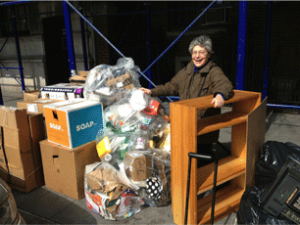
“Leave the gun, take the cannoli” is a famed line from the movie, “The Godfather” (Image: Marcelo Clapp)
Food waste has been a pet peeve of mine for many years, and it appears that I am not alone! According to a recent survey, Americans feel guiltier about wasting food than any other environment-related (mis)behavior (e.g., wasting water, leaving on the lights, forgetting to bring reusable bags to the store).
The Food Waste Issue
As a member of the “clean plate club” since childhood, and a marketing professor interested in effective and efficient satisfaction of consumer needs, I am frustrated and saddened that about 40 percent of all food in the U.S. (and one-third globally) is discarded, uneaten — lost somewhere along the way from farm to store to home to plate to stomach. The environmental and economic impacts seem staggering, not to mention the dual tragedy of losing food that could have fed the hungry and needless slaughter of all that fish, poultry, and livestock.
Remember the huge salad on the buffet that no one touched because it didn’t fit on those tiny plates and no one wanted to risk having greenery stuck in their teeth? And the bruised peaches that we all pinched and rejected at the store while searching for the three perfect ones we put in our basket? Unless arrangements had been made to donate that food, it probably ended up in a dumpster. If not composted or rescued by a freegan, it journeyed on to the landfill, to produce methane instead of nourishment.
Two Books by Jonathan Bloom & Tristram Stuart and a New NRDC Report
At least two books have addressed the subject — American Wasteland: How America Throws Away Nearly Half its Food by Jonathan Bloom, and Waste: Uncovering the Global Food Scandal by Tristram Stuart. Now a new NRDC report (Wasted: How America Is Losing Up to 40 Percent of Its Food from Farm to Fork to Landfill) documents the key issues at every point in the supply chain and identifies potential remedies that will increase efficiency.
Food Network Special: “The Big Waste”
Perhaps the most compelling illustration of the nature and scope of food waste was a Food Network special, “The Big Waste,” aired in January 2012. Two teams of celebrity chefs were challenged to create a gourmet banquet using only food that was going to be discarded. Food rescued from farms, groceries, bakeries and butcher shops included eggs that were too large for the cartons, poultry with broken wings, and cosmetically imperfect produce. The resulting dinner dazzled the chefs and diners alike. Segments from the show are still accessible here.
Responsible Consumers Can Influence Change
As Raz Godelnik has noted, guilt alone may not motivate consumers to change their behavior, especially when balanced against modern families’ need for convenience, and the relatively low cost of food. I agree with Godelnik’s assertion that the problem cannot be solved without considering the larger problem of how Americans produce and consume food. But while lobbying for responsible actions by government, food companies, retailers, restaurants, and farmers (as recommended by the NRDC report and others), I feel that responsible consumers have the power to take the lead on this issue. Not only can we reduce our own food waste, but we can use our influence to drive cultural change — perhaps back to the days when our society cared more about it.
Take that Doggie Bag!
I confess that I personally gave up cooking when I realized I wasn’t reaching any hearts via their stomachs. While I am willing to slice, scoop, chop, pour, reheat, and arrange food on plates, my family has gratefully outsourced all other meal preparation to trained professionals in restaurants, delis, and takeout shops. So though I may be less involved with food preparation and waste prevention in the home (addressed so well by fellow Waste Watcher Jocelyn Deprez on this website), I am keenly aware of food waste in out-of-home situations.
When I’m involved with event planning, I always recommend ordering food that we know will be most popular with the guests, and in reasonable amounts. I forwarded the NRDC Report to the catering manager at our college, and plan to share it with others. I also try to be less wasteful when I dine out. If I know I’m not going to eat the potatoes that come with the entrée, or the scoop of beans that come with the salad, I am getting in the habit of asking that they be left off the plate. Doggie bags help ensure that the rest gets eaten (though perhaps we should bring our own containers to reduce packaging waste), and if there are a few slices of bread in the basket, I slip them in as well. I hope people realize that anything left on the table (or buffet), even if untouched, cannot be reused or served to anyone else and must be discarded.
So leave the gun, take the cannoli and the bread basket!
What strategies do you use to reduce food waste? Do you feel that we as consumers can or should be more vocal about this issue and try to bring about change in the system? What wasteful practices have you witnessed? What practical solutions can you share.
Ed. Note: Be sure to check out World Food Day, National Food Day, and NYC Food Day being celebrated today, October 24th!




I’m with you, Fredrica, sometimes the bread in restaurants is home made and wonderful — and really worth taking home. Maybe we should invent portable “bread baskets” to accompany the “doggie bags”!
Buy small quantities fresh, eat out infrequently. Peruse your larder daily, feature whatever’s threatening to spoil. Use yer freezer, save the bones and veg peelings to make your own stock. Know your counterman, which means shop at food shops that have a counterman, he can provide human-scaled quantities. Keep mason jars around so you can ‘can’ leftovers for much later use. Keep a composter to turn kitchen waste into garden mulch.
When you ask to doggie bag excess food at a restaurant, do you get a look from your friends? I have several times as it gives me the appearance of being stingy.
I explain to my friends the environmental reasons why but still – there’s a cultural stigma to it.
Maybe there should be a campaign to rebrand the perception of doggie bagging something to being heroic and cool? Perhaps even changing the name of it?
Yes, Melissa. We need to rebrand doggie bags to make it cool. We ALSO need to redesign doggie bags to make them more pkg efficient. (Sometimes I think I’m taking home more pkg than food!) Would love to make it cool to bring your own portable doggie (or people?) bag. Maybe a variation on the reusable lunch box?
I agree with both statements and would take it one step further.
Melissa, you stated there is a stigma for appearing stingy and how perspectives need to change. While campaigning and rebranding is a good start, most consumers need a call to action, and in this case this would involve the design of a product/opportunity for them to adopt. Ultimately, there needs to be a cultural change. This would come from businesses both providing the opportunity for consumers to feel “cool” doing this through branding and through product design like Admin sugguested. Making packaging more efficient is a good example and also maybe designing bags that make it more convenient to carry your own “cool” take out ware. Packaging is one aspect, but convenience is also what makes the decision making process easier for the consumer to adopt.
I always thought about if one day consumers would feel normal carrying one set of utensils and a glass jar all the time, like a person in the wild would carry a knife. This would significantly reduce need for disposable food ware and decrease costs for businesses. This glass jar could act as a water bottle, cup, bowl, etc. As businesses open up, consumers are able to enter an environment feeling comfortable adopting alternative methods. There is an opportunity for communities and culture to develop. This could help businesses acquire more customers by generating traffic that would not have existed before. Moreover, an incentive would have to be created. Customers can either be rewarded with discounts if they have their own take out ware or charged if they don’t. We humans like positive feedback too. 🙂
There are so many dynamic opportunities.
Food waste is also such a pet peeve of mine and the fact that the US tosses 40% of it’s food is simply a disgrace!! My first hand observation is that many folks who shop at stores such as Sam’s club & Costco buying produce en masse wind up throwing most of it away. I have seen this time and time again. It also seems like there should be some level of accountability by large grocers like providing on-site composting with soil going back out into the community – or something. People just need to STOP buying in such bulk. It’s ridiculous.
Another thing is that I know so many folks who think they are too good for left-overs and refuse to eat them. It’s crazy! Left-overs are the best. I have intercepted many a left-over that were destined for the trash bin – and some mighty tasty treats indeed! I have no problem taking a doggie bag home and that includes the bread! I do agree that I wish the packaging was less and cringe at places that still use styro-foam – gasp!
Thankfully, I am blessed with friends and neighbors who are on the same page with avoiding food waste. I have learned to bring my own containers when going over to their house for dinner – lest I get a tongue lashing (in a good way) for not doing so. And one of my neighbors consistently shows up my when she is cleaning out her fridge/freezer of yummy organic goodies which she is all to willing to share and I all to willing to receive. We grew lots veggies all summer in our gardens and shared – NOTHING went to waste. Hail to the compost bin too!
There are things that really do need to change within the system and consumers need to be more accountable for their behavior as well.
Although I had a general idea that food waste was a problem in this country, I had no idea that the numbers were that high. 40% is wasted!?!? That number is so astronomical when you think about the millions of people who could use that food to survive. I feel like there needs to be a non-profit organization in place that is in charge of removing food “waste” from participating locations and delivers it to people in need. The reason why I put “waste” in quotes is simple, because none of the food wasted is actually waste. That is the problem. Food vendors stock their shelves and fridges with so much extra food that the amount they throw away is disgusting.
The recent events of Hurricane Sandy actually got me thinking about this topic due to some things I witnessed. I live in central New Jersey, and my area got hit pretty hard. Most businesses were closed for at least a week, and some were able to stay open due to generators. I went to a deli about 5 or 6 days after the storm, and although this particular deli was still getting food delivered, they were almost out of everything by 1 PM. The rush of demand from this little deli on the edge of town was unbelievable, and it got me to think about a normal day for businesses like this. Like how on a normal day, there is countless amounts of food that they simply discard, and all it took was a natural disaster for them to sell all of their perishable food in one day. Seems like it’s going to take more natural disasters like Sandy to finally wake people up to the problems this world is facing.
40 percent of food wasted is such a staggering number – I had no idea it was that high. One of the things I try to do to prevent food waste is plan my meals for the week before I go shopping. That way, I can make recipes that share some of the same ingredients so I can be sure they are all used up by the end of the week.
I would love if there was a way to bring the leftover bread from the bread basket home from a restaurant! Often times I’m forced to choose whether I want to eat all of the bread, and not be able to finish my meal, or leave the bread and eat all of my meal. It would be great if the portion sizes were smaller to allow both, but I know that’s a whole other discussion.
One of the non-wasteful practices I have seen is that of Pret a Manger, a British chain that sells premade sandwiches and salads (all over the UK, and starting to have a presence in the US). They make their food fresh throughout the day but sell it already packaged, so in order to avoid throwing it out at the end of the day they donate all leftovers to the homeless each night. Not only is it environmentally responsible to avoid the landfill, but it is socially responsible as well to give back to the communities where their stores are located. Hopefully that is a practice that will catch on in other restaurants in the near future.
I agree it’s definitely one of the greatest issues to tackle, especially as our population is growing. The problem of starvation has never been that there is not enough capacity to feed everyone, but unequal distribution of agriculture land and the food waste along the production chain. It’s ironic that food that could feed 2 billion people are being thrown away each year in the US only, and at the same time around 1 billion is starving around the world! Trade barriers is a tricky issue; some easier problems to handle could be improved refrigeration, packaging and sanity.
What I try to tell people is to trust their basic instincts (smell and taste) when judging food quality, instead of trusting the “best-before-dates”.
A good investment is “green bags” which keeps produce fresh for weeks (and careful as I am, I re-use those bags several times). One other grander idea I have thought of is to start a food chain that would sell all the “non-pretty” food that never makes it to the regular food stores. The off shaped and off colored produce. If educating people about food waste, and also enabling lower retail prices as the purchase price could be set lower, I think it could work!
Consumers can eat perfectly good but “expired” foods; the food industry can’t. Food health and sanitation laws do seem a bit over-the-top, but are generally more good than bad. I say this after living in Ethiopia for a year, where cafes slid all food scraps into plastic bags and handed them out to homeless children waiting in the street. This was great for not wasting food, but even better for the amoebas and tapeworms added to the food by the cooks, waiters, and eaters. Yikes. Some regulations are appreciated.
Organizations like Food Not Bombs help redraw the line between safe food and dirty waste by collecting ugly, off foods that groceries and restaurants think consumers won’t touch, and serving healthy dishes to people facing hunger. Because this is done in a public space, it convinces all the people who aren’t reading these comments that bruised produce and yesterday’s breads are not contaminated.
I believe the food waste issue needs to be addressed from top to bottom. It is because of these certain regulations that those eggs that don’t fit into their Styrofoam container get discarded or because that beet grew a bit off. If those rules and regulations were altered then perhaps the % of waste would be lower. Or if the supplier used what was not edible for other things such compost then again, less waste.
The next level would be supermarkets, retailers, and distributors. I understand that a large portion of food is thrown out once it is past it’s due date and I do believe there are efforts in saving these foods that are expired but still edible (as foods that expired are usually still edible for a while after) and donating them to the poor. This is something grocery shops and retailers should set up or we can set up. It prevents waste on their part and helps both sides out. I personally love when supermarkets have a section of fruits and vegetables that are selling for very low prices because they are bruised or imperfect. These are great for soups or cooking that night – which is when I usually prepare meals. That is why I like Christina’s comment regarding opening a store enabling shoppers to purchase off color or off shaped produce for lower than retail cost.
Regarding restaurants, I’ve seen plenty of waste there. Whereas at the dinner table you can always save leftovers for the next day’s lunch in a Tupperware; at a restaurant it is slightly awkward to pull out your Tupperware just as the waiter is about to take away the bread basket and set down your main course in order to save the bread from being wasted. The same goes for your leftover french fries, there is a stigma and I can see myself turning into ‘that girl’ or ‘Tupperware girl.’ Take-home bags from restaurants are a whole different ball game because they do allow you to save your food (usually minus the bread) but they often are Styrofoam containers as those are the cheapest (and most harmful for the environment), they are bulky, and again, you don’t want to be ‘that’ person.
Personally I mostly eat at home and try to never leave any waste, when you don’t have much money to waste you don’t leave waste. As someone mentioned the story of Hurricane Sandy doing a good thing for a local deli, this is how I reduce food waste as well, I eat everything.
I think it is important to explain to others this is not an ‘I’m too good for that’ type of thing, it is an I don’t feel like wasting and this could be tomorrow’s lunch, then I won’t have to worry about purchasing a sandwich. And then you save more money by wasting less. And then, look at that, you will be able to go on a lovely vacation with all of that money you’ve saved one day. So, yes, I do believe it is important to get more people to be proud to take home food and not waste. Waiters and waitresses can even help with the cause by pushing their customers to take home their leftovers.
There should be a surcharge for not being “a part of the clean plate club”…. Now that would make a difference!
The impact of food waste is not just financial. Environmentally, food waste leads to wasteful use of chemicals such as fertilizers and pesticides; more fuel used for transportation; and more rotting food, creating more methane – one of the most harmful greenhouse gases that contributes to climate change. Methane is 23 times more potent than CO2 as a greenhouse gas. The vast amount of food going to landfills makes a significant contribution to global warming.
I certainly feel that costumers need to be more vocal about the prevalent issue of food waste. Understandably, this would be much easier without the stigma that many of the prior commenters addressed, and I feel this can only happen gradually. With steps such as the Food Network Special Fredrica referenced, as well as a stress on the monetary value of wasted food, I am confident the stigma will subside, resulting in less waste. Similarly, I am a firm believer in general education regarding similar issues — even if someone is not “concerned with the environment,” associating wasteful acts with money, as discussed, may help them change their views, and more importantly, their actions.
In addition, I understand that not everyone has a grandmother like mine, who commonly had limited means with ten children to take care of, and consistently takes home everything in doggie bags — bread baskets, as well as any food left over, no matter the amount. While she ignores any “stigma,” I realize it may be easier for her to do more so than others. Even so, little steps such as not ordering an appetizer, ordering half-portions, or simply not over-ordering can significantly reduce waste while simultaneously avoiding the stigma of doggie bags.
I feel it is important to note, however, that I believe this stigma is more feared than actually expressed. I have personally never felt a stigma when asking for a doggie bag, and even for those that do, keep in mind your greater contribution to both the local and global environment. And you never know — your actions could affect those of the diner next to you and encourage others to make the same choices.